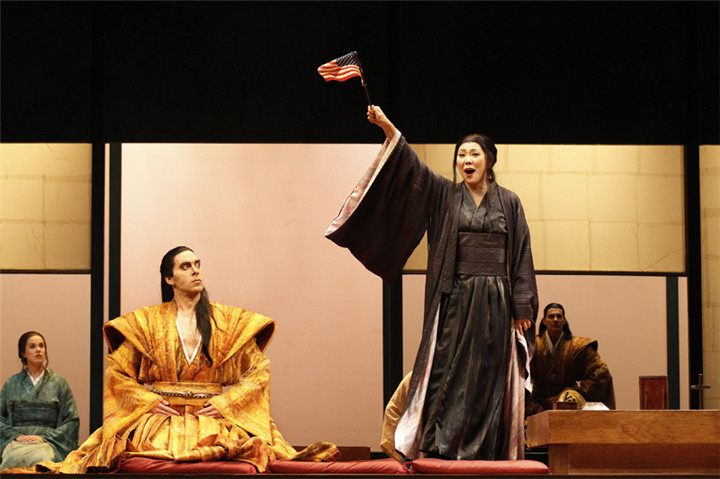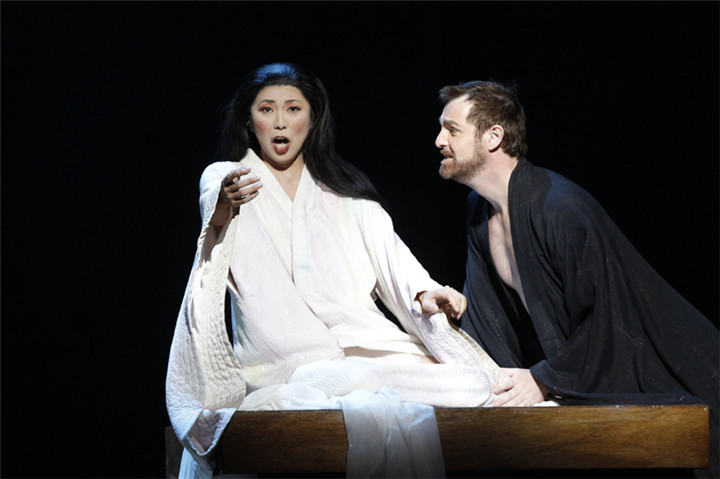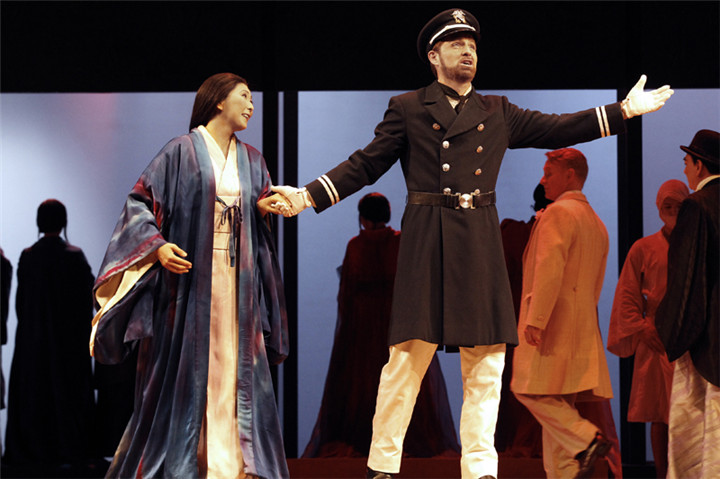Emotional Madame Butterfly woos local audiences
Writer: Debra Li | Editor: Doria Nan | From: Shenzhen Daily | Updated: 2018-10-18
For the first time, an original production by a foreign opera company will meet local audiences.
Opera Australia’s “Madame Butterfly” will be staged at Shenzhen Poly Theater on Friday and Saturday evenings. The chorus and orchestra of China National Opera House will provide the music under the baton of Tang Muhai.

A scene from “Madame Butterfly.” Courtesy of Shenzhen Poly Theater
Andy Morton, revival director of the classical Puccini opera, promises the 130-minute show will be an intense, emotional and beautiful experience.
The production, first created by Moffatt Oxenbould in 1997, was set in 1904, the same year Puccini originally debuted it. Many other versions of the long-time favorite by the great composer set the piece in a more recent time, but Morton said Opera Australia had good reason to choose otherwise.
“It’s quite important to understand the drama of this opera. When American sailor Pinkerton and his young geisha wife Cio Cio San (Butterfly) are separated, they cannot communicate for three years, which is only believable at that time,” that is, before modern technology changed everything.
Though it’s a story from a century ago, Morton said the emotional impact of the story is for all time, because “we understand love, loss, heartache, and all those things that make this opera so emotionally exciting to watch.”

Pinkerton (R) and Cio Cio San on stage.
The set and costumes designed by Peter England and Russell Cohen are simplistic and elegant, befitting Japanese aesthetics. Sensuous silk gowns flutter across wooden platforms. Flame dances on water surrounding the elevated center stage.
Using the basic elements of wood, stone, water, fire and air, the stage set helps the production to come to life, because Pinkerton “falls in love with not just Cio Cio San, but also the idea of an exotic oriental dream,” as Morton sees it.

Kwon Hye-seoung (L) as Cio Cio San and Paul O’Neill as Pinkerton.
In one particular scene the director mentioned at the end of act I, Pinkerton and Cio Cio San fall in love and sing about the starry night, and the background is raised up to actually reveal the night sky and the moon.
The main Kabuki feature being incorporated into the staging is the use of five koken — masked stage assistants who serve the actors and the action with their “invisible presence.” “They deliver props and help actors quickly change costumes. For example, they pass Cio Cio San a telescope in one scene so she can look out to the sea,” Morton explained. This device makes it possible to keep the stage empty and transform the stage into something a little like a film close-up, helping the audience focus on the performance of the singers.
The essential charm and challenge of opera is that “the orchestra, the singing voice and the drama are presented to the audience in one go,” said Paul O’Neill, a talented Australian tenor who will sing the role of Pinkerton.
“Singing opera, especially Puccini, is like an Olympian of the voices, like heavy weightlifting. It takes 10 to 15 years to slowly build up your voice, which needs to be heard singing beautifully on top of a 60-piece orchestra. It takes a lot of efforts and practice to be precise, both in sound and emotional expression,” O’Neill said.
Kwon Hye-seoung, the South Korean soprano who will sing Cio Cio San, said she took ballet lessons for the role, as geishas are required to be elegant dancers. “The box-set stage with its intimacy gives me the freedom to act naturally without exaggerated gestures and focus on the singing,” she said.
With both Chinese and English subtitles, it’s easy for the audiences to watch “Madame Butterfly” and enjoy it because they can live each moment as it happens. “This is a love story going wrong. People will feel for the purity and devotion that Butterfly stands for,” O’Neill said. “This production is very straightforward, and the music tells the story.”
While Morton noted that it does take a lot of new ideas and efforts to develop young audiences for opera, O’Neill pointed out that the digital era offers up new opportunities for the old art, with greater accessibility from streaming services.
Opera Australia, founded in 1956, gives 600 performances each year. Its Chinese tour of “Madame Butterfly” also includes legs in Tianjin, Qingdao and Zhuhai, with two shows in each city.
Time: 8 p.m., Oct. 19-20
Tickets: 280-2,880 yuan
Venue: Shenzhen Poly Theater, intersection of Wenxin Road 5 and Houhaibin Road, Nanshan District (南山区后海滨路与文心五路交界处深圳保利剧院)
Metro: Line 2 or 11 to Houhai Station (后海站), Exit E